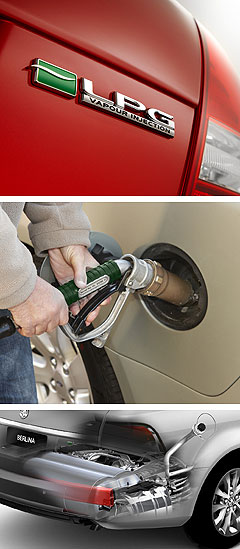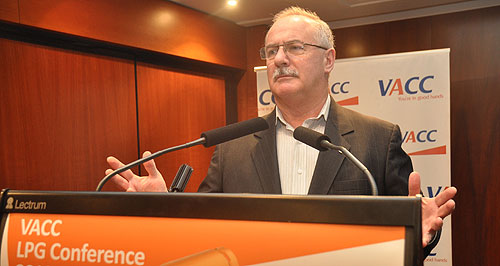Make / Model Search
News - General NewsFresh campaign from LPG industryFuelling the cause: GEA chief executive Mike Carmody wants the federal government to encourage more LPG use. Gas industry launches online election campaign to pressure MPs to adopt new policies3 Sep 2013 By IAN PORTER THE automotive LPG industry has made a late entry into the 2013 election by launching a campaign urging the federal government to do more to encourage a switch from liquid transport fuels to gas. The industry’s peak retail body, Gas Energy Australia, has created a dedicated website ‘Election Hub 2013’ and is encouraging the 9000 employees of its member companies to pepper the email accounts of their local MPs with preformed letters urging a change in policy. GEA chief executive Mike Carmody told GoAuto that the association wants the government to freeze the excise on LPG, which is currently at 7.5c a litre but is rising in stages to 12.5c a litre, link assistance to the automotive industry to the promotion of LPG-powered cars and to exclude LPG vehicles from the recent tightening of regulations around the fringe benefits tax. “It just makes sense,” Mr Carmody said. The proposed legislative changes were not designed simply to benefit the gas industry, he said, but were designed to benefit the whole country. The industry argues that Australia would be better off if it used more liquefied petroleum gas (LPG), compressed natural gas (CNG) and liquefied natural gas (LNG). “Using indigenous fuels will improve the country’s energy security,” Mr Carmody said. According to GEA, replacing expensive imported oil with locally produced gas would also take a heavy burden off the country’s balance of payments. Second, using more gas would help cut carbon emissions and be beneficial for the environment. An LPG vehicle produces up to 16 per cent fewer emissions than a petrol vehicle. Third, gas is just cheaper than petrol and diesel. Mr Carmody said LPG was currently 50 per cent cheaper than petrol and offered big reductions in operating costs both for corporate fleets and individual drivers. Mr Carmody said he was unsure how much revenue a freeze on LPG excise would cost the government, but he said this would be more than made up by a reduction in the cost of carbon emissions abatement. The less carbon that is emitted means less money will have to be spent generally on reducing the country’s carbon emissions to meet the minimum national target. The aim is to reduce emissions by 2020 at least to a level equivalent to 5 per cent below the emissions in 1990. “We are saying gaseous fuels have an enormous contribution to make to carbon reduction,” he said. “Whether you’re working under an RET (renewable energy target) or some sort of emissions trading, or if you go with the Coalition’s direct action, fundamentally, the government would get a big win.” Mr Carmody said promoting the use of gas as a transport fuel could help achieve two government policy targets at the same time. “If you are going to be funding an auto industry, all or part of that funding should be tied to a vehicle that actually delivers something,” he said.  “Currently, it is tied to a volumetric model GM, Ford and Toyota simply produce numbers of cars. “But what we are saying to the (Labor) government and the Coalition is, while that is good, wouldn’t it be smarter to tie the assistance to a vehicle that delivers something in return: indigenous fuel, cleaner burning, and half the price at the pump?“Then everyone gets a kickback from the investment going into the auto industry.” Sales of new LPG cars have slumped further this year, with figures to the end of July showing declines across private and business segments in passenger and light commercial vehicle segments. Passenger car LPG sales, which are largely the domain of the Ford Falcon and Holden Commodore, and have traditionally attracted strong support from the taxi industry, are down 20 per cent this year among business buyers and a massive 45 per cent with private buyers. With taxis, LPG has been losing ground to hybrids, particularly the Toyota Prius, and Mr Carmody said the gas industry was working to regain its former position as the fuel of choice in that market. “The taxi industry is moving towards the hybrid,” Mr Carmody said. “The hybrid stacks up well on the profit and loss statement, although there are some outstanding issues on the balance sheet concerning the replacement of batteries, the resale of the vehicle and the high purchase price of the vehicles. “I think the taxi industry needs time to work out whether it is getting true value out of the hybrid at the end of the day.” However, Mr Carmody said the gas industry could still benefit even if the taxi industry continued to move towards hybrids. “We have the ability now as an industry to start converting those hybrids from petrol hybrids to gas hybrids. We have a number of people in Melbourne moving into that space and creating value for the taxi industry.” He said he did not believe the addition of an LPG canister into the boot of a hybrid, which is already compromised by a battery pack, would prevent the gas hybrid from becoming popular with taxi operators. The perception is that business travellers are increasingly travelling lighter and not staying overnight as much as they used to when they went interstate. “It’s basically one person going up, with an iPad, having a short meeting and getting on a plane and flying back, so the demands on space in the taxis are changing dramatically now. “The Prius and Camry are obviously smaller vehicles than the Commodore and Falcon, but the nature of the passenger has changed.” Mr Carmody said it was now down to the industry – GEA’s members – to ramp up the promotion of the three different gases, which he said were suited to different sectors of the transport industry. “As part of that broad gaseous fuels scene within the alternative fuels landscape, this is where we as an industry have to start ramping up the message, getting it out to the community, business organisations and fleets, clearly articulating where and how we see these fuels deployed for value and benefit,” he said. “Macro-wise, you have Autogas in passenger vehicle, as you move up into LCV, bus, light truck you have CNG coming in, and as you move into the heavy, long haul sector, you have LNG sector coming into its own.”  Read more8th of March 2013  LPG industry lights the pilotAlternative fuel group aims to curb decline of gas conversions24th of May 2012  LPG conversion demand dives71 per cent fall in LPG car conversions has industry on the ropes |
Click to shareGeneral News articlesResearch General News Motor industry news |











Facebook Twitter Instagram